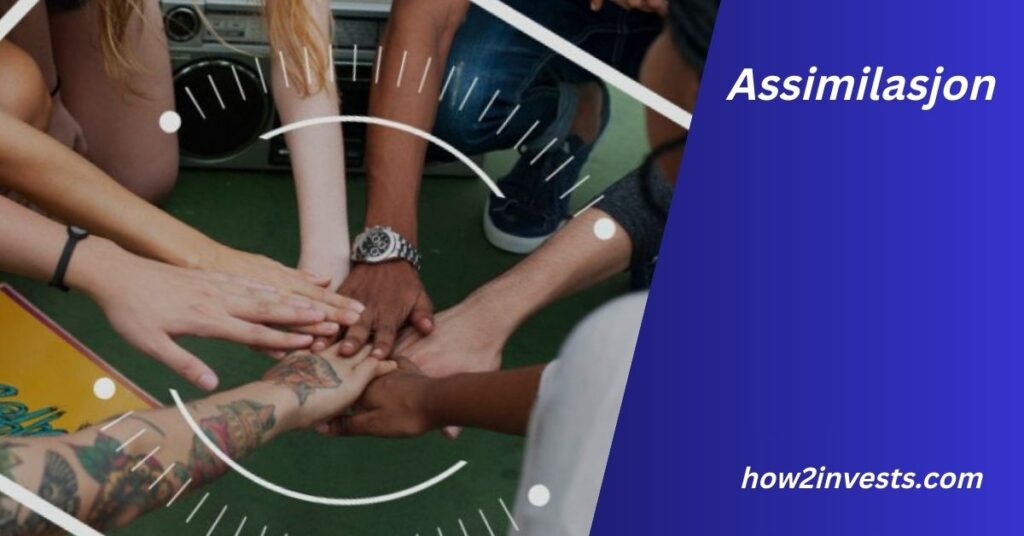Assimilasjon: A Comprehensive Guide to the Process of Cultural Assimilation

Assimilasjon, or assimilation, is a term that refers to the process through which individuals or groups from different cultural, ethnic, or social backgrounds gradually adopt the customs, practices, beliefs, and values of the dominant culture or society they join. This is a phenomenon that has shaped societies around the world and has played a significant role in shaping the history and development of nations. Understanding the concept of assimilasjon is essential in today’s increasingly interconnected world, where migration, globalization, and cultural exchange are more prevalent than ever.
In this article, we will dive deep into the concept of assimilasjon, exploring its historical roots, its various forms, its impact on individuals and societies, and the ongoing debates surrounding its practice. Additionally, we will answer some frequently asked questions to shed light on this complex and often misunderstood concept.
What is Assimilasjon?
Assimilasjon is a process that involves the integration of individuals or groups into the cultural and social framework of a larger society. This often means adopting the language, customs, values, and practices of the dominant culture while possibly leaving behind some aspects of one’s original culture. Assimilasjon is most commonly seen in the context of immigration, where immigrants may gradually align themselves with the norms and expectations of the country they have moved to.

However, assimilasjon can also occur within smaller communities or social groups, where individuals change their behavior and attitudes to fit in better with the social environment. This process can be voluntary, where individuals choose to assimilate for economic, social, or personal reasons, or it can be forced upon them due to social pressures or government policies.
Historical Background of Assimilasjon
The concept of assimilasjon is not a modern phenomenon. It has occurred throughout history, especially in the context of empires, colonialism, and migration. Historically, when large groups of people moved from one region to another, they often encountered dominant cultures that shaped the social and political landscape of the new land.
Also Read: Lwedninja: The Rising Digital Identity Blending Originality with Ninja Agility
For example, during the colonial era, indigenous populations were often subjected to assimilasjon, as colonial powers sought to impose their own culture, religion, and values on the native people. In the United States, the forced assimilation of Native Americans through policies such as the Dawes Act and the boarding school system is a painful chapter in the nation’s history. Similarly, European immigrants to the U.S. in the 19th and 20th centuries often underwent a process of assimilation, adopting American customs and shedding parts of their heritage.
Over time, assimilasjon has evolved, with various governments and societies adopting different approaches to integrating immigrants and minorities into the social fabric.
Different Types of Assimilasjon
Assimilasjon can manifest in various ways, depending on the circumstances and the level of integration expected by the host society. There are several forms of assimilasjon, including:
a. Cultural Assimilasjon
This is the most common form of assimilasjon, where individuals or groups adopt the cultural practices of the dominant society. This may include changing language, dress, food preferences, and social behaviors.
b. Social Assimilasjon
Social assimilasjon involves the process of becoming integrated into the social networks and relationships of the dominant group. This could mean building friendships, working within the same industries, or participating in community events.
c. Structural Assimilasjon
This type of assimilation occurs when immigrants or minority groups gain access to social institutions like education, employment, and political participation, ultimately achieving a degree of equality within the broader society.
d. Psychological Assimilasjon
This is a more personal form of assimilation, where individuals internalize the values and beliefs of the dominant culture, often leading to a change in identity or self-perception.
The Process of Assimilasjon: How Does it Happen?
The process of assimilasjon typically occurs over time and can be influenced by various factors such as the degree of cultural difference between the immigrant group and the host society, the policies of the host country, and the willingness of the immigrant group to integrate.
Also Read: faqvehicle .com: Your Ultimate Resource for Automotive Questions
a. Initial Contact
When an individual or group first arrives in a new society, they experience what is often referred to as the “honeymoon” phase. In this phase, the newcomers may feel excited about their new life and open to the idea of blending into the new culture.
b. Adjustment and Adaptation
After the initial excitement, individuals begin to encounter challenges as they adjust to the new environment. This can include language barriers, cultural misunderstandings, and the struggle to find a sense of belonging.
c. Full Integration
Over time, as individuals acquire new skills, form social networks, and adapt to their new surroundings, they may experience full integration into the host society. This process is gradual and may take several generations.
Factors Influencing Assimilasjon
Several factors can influence the speed and success of assimilasjon, including:
a. Government Policies
Some countries encourage or even require immigrants to assimilate through laws and policies. For example, language requirements or citizenship tests may play a role in promoting cultural integration.
b. Social Support Systems
The presence of support networks, such as immigrant communities, can affect how easily newcomers adapt. In societies where these networks are strong, individuals may face less pressure to assimilate quickly.
c. Individual Willingness
The personal willingness of immigrants to assimilate is also crucial. Some individuals may be eager to adopt the customs of the new society, while others may prefer to maintain their cultural identity.
d. Cultural Openness
Host societies that are more open to diversity and multiculturalism may facilitate a smoother assimilation process. Conversely, in societies with rigid cultural norms, assimilation may be more difficult.
Positive and Negative Impacts of Assimilasjon
Assimilasjon can have both positive and negative consequences, both for the individuals involved and for the society as a whole.
Positive Impacts:
- Social Cohesion: Assimilasjon can help integrate immigrants into the social fabric, promoting unity and reducing social fragmentation.
- Economic Opportunities: Immigrants who successfully assimilate may gain better access to employment, education, and social services, improving their quality of life.
- Cultural Exchange: The process of assimilasjon can lead to the blending of cultures, creating a richer, more diverse society.
Negative Impacts:
- Loss of Identity: One of the biggest concerns around assimilasjon is the potential loss of cultural identity. Immigrants may feel pressured to abandon their heritage to fit in.
- Social Exclusion: Not all groups are equally successful in the assimilation process. Some individuals may experience discrimination or exclusion, despite their efforts to integrate.
- Cultural Homogenization: In some cases, assimilation can lead to the erasure of cultural diversity, as minority cultures may fade into the background.
The Role of Language in Assimilasjon
Language is often considered the cornerstone of assimilasjon. The ability to speak the dominant language is crucial for social, educational, and economic integration. In many cases, immigrants are encouraged or required to learn the language of the host country to facilitate communication and participation in society.
Also Read: Pappedeckel: The Eco-Friendly Solution for Food Packaging
However, language can also be a barrier to assimilation, especially for those who are not fluent in the dominant language. In some cases, the pressure to learn a new language may lead to a loss of fluency in one’s native tongue, further contributing to the erosion of cultural identity.
Assimilasjon vs. Multiculturalism: What’s the Difference?
Assimilasjon and multiculturalism are two different approaches to cultural integration, and they often stand in contrast to one another.
- Assimilasjon focuses on the idea that immigrants should adopt the cultural norms and values of the dominant society. The expectation is that integration requires giving up or altering aspects of one’s original culture.
- Multiculturalism, on the other hand, promotes the idea that cultural diversity should be celebrated and preserved. It encourages individuals to maintain their cultural heritage while also contributing to the broader society.
Globalization and Assimilasjon
In today’s globalized world, the process of assimilasjon has become more complex. As technology, media, and communication have made the world smaller, cultures are constantly interacting with one another. This has created opportunities for more fluid and flexible forms of assimilation, where individuals can retain aspects of their heritage while also participating in the dominant culture.
Globalization has also led to increased migration, meaning that countries are now dealing with larger and more diverse immigrant populations. As a result, the traditional model of assimilation is being challenged by new, more inclusive approaches that seek to embrace diversity rather than enforce conformity.
Challenges and Controversies Around Assimilasjon
Assimilasjon is not without its challenges. There are significant debates about its fairness and effectiveness. Critics argue that it can lead to the marginalization of minority cultures and the loss of cultural richness. On the other hand, proponents of assimilation emphasize the need for social cohesion and shared values.
Also Read: nothing2hide net gaming: Everything You Need to Know
Some of the key challenges include:
- Cultural Imperialism: The imposition of one culture over others can be seen as a form of cultural imperialism, where the dominant culture suppresses minority cultures.
- Resistance to Assimilasjon: Some immigrants resist assimilation because they feel that it requires them to abandon their identity or values.
- Racial and Ethnic Inequalities: Assimilasjon does not always lead to equality, especially for marginalized racial or ethnic groups who may continue to face discrimination even after adopting the dominant culture’s norms.
How Assimilasjon Affects Immigrants and Minorities
The process of assimilasjon can have a profound impact on immigrants and minority groups. While it can offer opportunities for social mobility and integration, it can also lead to feelings of alienation and cultural loss. Immigrants may feel caught between two cultures, trying to balance their native heritage with the expectations of the dominant society.
For minority communities, assimilasjon can sometimes result in the erasure of their cultural practices, languages, and traditions. This can lead to a sense of disconnection from both their homeland and the host country.
The Future of Assimilasjon in a Globalized World
As the world becomes more interconnected, the future of assimilasjon will likely evolve. The rise of multiculturalism, transnationalism, and the increasing recognition of cultural diversity may lead to a shift away from traditional assimilation models.
At the same time, the continued movement of people across borders will ensure that assimilasjon remains a central topic of discussion in global policy and social discourse. The challenge for societies in the future will be to find ways to balance the integration of immigrants with the preservation of cultural diversity.
Frequently Asked Questions About Assimilasjon
What are the main stages of assimilasjon?
Assimilasjon typically progresses through stages: initial contact, adjustment and adaptation, and finally, full integration into the dominant society.
Is assimilasjon the same as acculturation?
While similar, assimilation focuses on adopting the dominant culture, while acculturation involves the exchange of cultural traits without fully adopting the dominant culture.
Can assimilation lead to the loss of identity?
Yes, assimilation can lead to the loss of cultural identity if individuals are pressured to abandon their native customs and traditions.
How long does the process of assimilasjon take?
The length of assimilasjon can vary depending on factors such as the level of difference between cultures, government policies, and the willingness of individuals to integrate. In some cases, it may take generations.
Is assimilasjon always a positive process?
Assimilasjon can have both positive and negative effects, depending on the individual’s experience and the society’s approach to integration. It can lead to social mobility but also create feelings of alienation and loss of cultural identity.
Conclusion
Assimilasjon, or assimilation, is a complex process where individuals or groups adopt the customs and values of a dominant culture. While it can lead to social and economic benefits, it also risks erasing cultural identity and creating feelings of exclusion. In today’s globalized world, the debate between assimilation and multiculturalism continues to shape how societies integrate newcomers. A balanced approach that values diversity and fosters inclusivity is essential, allowing individuals to retain their cultural identity while fully participating in their new society. Ultimately, the future of assimilasjon should aim to celebrate diversity and promote mutual respect.




